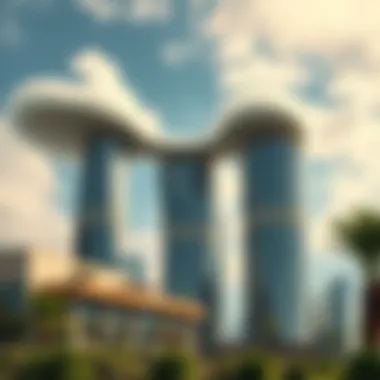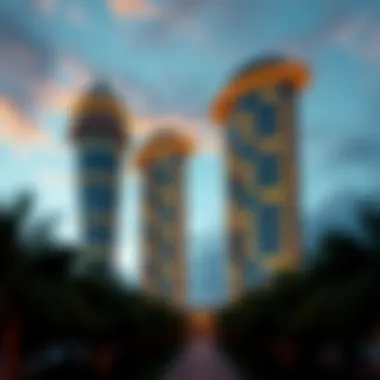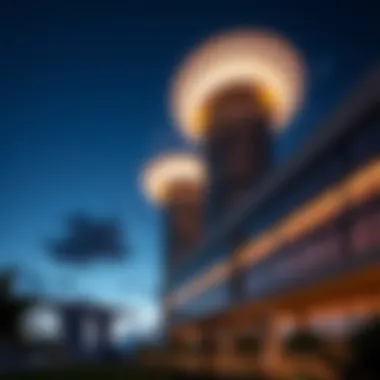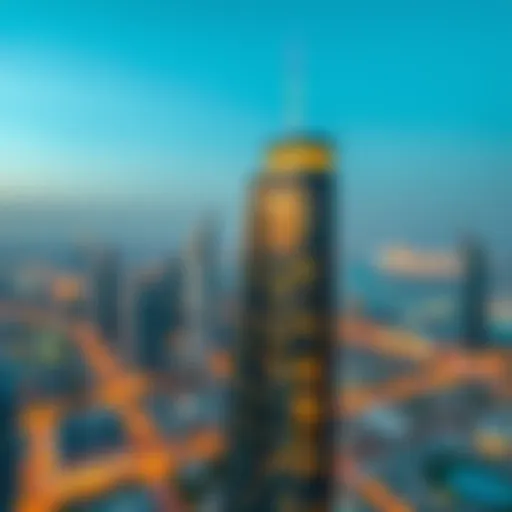Exploring Cloud Towers in Architecture and Urban Design


Intro
The sky's the limit, or so it seems with the emergence of cloud towers in modern architecture. These towering structures aren't just reaching for the heavens; they're reshaping the urban landscape in cities around the globe. Specifically, they serve as symbols of innovation, sustainability, and, of course, aspiration. As urban populations swell, cloud towers present solutions that meld aesthetics with functionality, making them an attractive investment for those in the know.
Understanding cloud towers involves more than just a gaze upward. It’s about evaluating their implications on urban life, market dynamics, and socio-environmental frameworks. This exploration seeks to illuminate the layers that constitute cloud towers, unraveling their potential and nuances within the context of contemporary urban planning—especially in locales like Dubai, where the skyline is continuously redefining itself.
So, let’s roll up our sleeves and dig into the nitty-gritty, uncovering how these titans in the sky are setting the stage for a new era of urban living.
Preface to Cloud Towers
The notion of cloud towers is becoming increasingly relevant in today's rapidly evolving urban landscape. These architectural marvels are not just structures; they embody the aspirations of modern cities and reflect the ambitions of urban planners and architects to redefine skylines. Importantly, understanding cloud towers allows us to appreciate their multifaceted role in urban development, from aesthetic contributions to environmental considerations. As cities grow and evolve, these towering structures invite us to rethink space utilization and community integration.
Defining Cloud Towers
Cloud towers can be defined as high-rise buildings that pierce the sky and symbolize the pinnacle of contemporary architecture. They are notable for their innovative designs and ability to create multifaceted spaces—often blending residential, commercial, and recreational areas. These buildings push the boundaries of traditional architecture by not only emphasizing height but also focusing on sustainable design, incorporating green technologies, and enhancing urban life.
In essence, cloud towers are more than just tall buildings; they represent a new approach to urban architecture where functionality meets fantasy. This blending results in structures that are visually striking and provide practical solutions to urban living challenges. For investors and developers, understanding this definition is crucial as it also highlights their potential for high return on investments through thoughtful design.
Historical Context
To grasp the evolution of cloud towers, we must first look back at the stories they tell through architectural history. The seeds of such structures can be traced to the early 20th century when the use of steel frame construction allowed buildings to rise higher than ever before. Iconic structures like the Empire State Building in New York City marked a turning point in architectural ambition, setting a standard for future developments.
However, the real leap into the modern era of cloud towers began in the late 20th century, as advancements in engineering and materials science enabled more daring and innovative designs. For instance, the Burj Khalifa in Dubai—not only the tallest building in the world—demonstrates the capabilities of modern engineering and has become a symbol of wealth, ambition, and destination in urban architecture.
This historical context underscores how cloud towers emerged from both technological advances and cultural aspirations. They reflect societal values by providing vertical communities amidst sprawling urban environments, making them a vital part of urban planning strategies. As urban centers grapple with limited space and growing populations, cloud towers stand at the forefront of innovative solutions.
Cloud Towers in Architectural Discourse
In the ever-evolving realm of modern architecture, cloud towers stand out not only for their towering height but for their role as beacons of both ambition and innovation. They have become a significant topic in architectural discourse, symbolizing the merging of aesthetics, functionality, and advanced engineering. This section explores the aesthetic innovations and structural engineering challenges associated with these impressive structures, emphasizing their importance in crafting urban landscapes.
Aesthetic Innovations
The design of cloud towers pushes the envelope of what’s visually and structurally possible. Architects utilize cutting-edge technology to create breathtaking forms, bringing artistic visions to life. These towers often resemble natural phenomena like mountains or waves, making a dramatic statement against the skyline. It's like the buildings are reaching for the heavens, claiming their place in a city’s identity.
Consider the Burj Khalifa in Dubai; its design, inspired by the hymenocallis flower, not only serves a practical purpose but is a work of art in itself. The aesthetic experience of cloud towers is marked by:
- Fluid forms that challenge traditional boxy shapes, offering a sense of movement and dynamism.
- Use of reflective materials that interact with light, changing appearance throughout the day.
- Integration of green spaces and terraces into the structure, creating a feeling of harmony with nature.
These innovations not only attract onlookers but also elevate the architectural narrative within the urban fabric, merging beauty with purpose. As cities continue to grow and evolve, such innovations in aesthetics will be a vital part of attracting tourists and enriching local culture.
Structural Engineering Challenges
While the appeal of cloud towers is immediately evident, constructing these giants presents a myriad of engineering challenges. These buildings are under constant pressure from winds, changing temperatures, and even seismic activity. This requires an interdisciplinary approach that blends acoustics, materials science, and aerodynamics. To put it plainly, building a cloud tower is like assembling a complex puzzle, where each piece plays a crucial role in the finished work.
Key challenges include:
- Wind Forces: Cloud towers must withstand extreme wind conditions. Engineers often conduct wind tunnel tests to ensure stability under various weather conditions.
- Foundation Requirements: Given their height, a strong foundation is essential, often demanding deep pilings that penetrate bedrock. This not only increases costs but complicates pre-construction activities.
- Vertical Transportation: With soaring heights comes the issue of efficient vertical movement. High-speed elevators and sophisticated lobby designs are employed to handle large volumes of people efficiently.
- Material Selection: Choosing the right materials is crucial. Lightweight materials help reduce the overall load while maintaining structural integrity. Advances in composites and reinforced concrete can greatly influence design decisions.
"Building a cloud tower isn’t just about engineering; it’s about realizing a vision that challenges the norms and anticipates future needs."
In summary, the discourse around cloud towers is as much about aesthetic expression as it is about overcoming significant structural hurdles. As cities continue to expand vertically, the implications of these towers will resonate far beyond their physical presence, influencing the very fabric of urban life.


Functional Aspects of Cloud Towers
The significance of cloud towers in modern architecture extends beyond their towering heights and impressive aesthetics. They embody a variety of functional elements that address the diverse needs of urban living. This section unpacks the practical reasons for adopting cloud tower designs, focusing on mixed-use developments and sustainability. These aspects contribute largely to what makes cloud towers not only attractive but necessary in today’s rapidly evolving cityscapes.
Mixed-Use Developments
Mixed-use cloud towers serve as microcosms of urban living, seamlessly integrating residential, commercial, and recreational spaces into one cohesive unit. By blurring the lines between these traditionally distinct functions, they foster an environment where people can live, work, and play in proximity. This is particularly advantageous in densely populated urban areas where land is at a premium, allowing individuals to minimize their commute and engage more with their community.
Here are some core benefits of mixed-use cloud towers:
- Increased Convenience: Many residents prefer not to travel far for everyday needs. A cloud tower with shops, parks, and offices below eliminates the need for daily travel, enhancing the quality of life.
- Enhanced Local Economy: By housing businesses within the same complex as residences, consumer foot traffic increases, stimulating local commerce. This is beneficial for property owners and entrepreneurs.
- Waste Reduction: Mixed-use spaces often share utilities and infrastructure, leading to reduced resource consumption compared to separate developments.
For investors, mixed-use developments hold appeal due to their diversified income streams. When a financial downturn hits one sector, the others can still provide stability, making these towers a sound long-term investment.
Sustainability Considerations
Sustainability has quickly become a priority in urban planning, and cloud towers offer innovative solutions to environmental challenges. Modern buildings face scrutiny regarding their carbon footprints and energy efficiency. However, the design of cloud towers allows for several sustainable practices integrated into their architecture and operations.
Key sustainability aspects include:
- Energy Efficiency: Cloud towers are often equipped with advanced insulation and energy-conserving technologies. For instance, smart building technologies optimize energy use based on occupancy, reducing waste.
- Green Roofs and Vertical Gardens: These features not only enhance aesthetics but also help in insulating buildings, managing stormwater, and promoting biodiversity.
- Utilization of Renewable Energy Sources: Integrating solar panels and wind turbines in design can significantly offset energy costs, creating a more sustainable operating environment.
- Water Management Systems: Innovative rainwater harvesting systems can be implemented to support irrigation and other non-potable applications.
Investors are increasingly looking for properties that meet or exceed sustainability standards, as these will likely retain value in the growing green economy. As cloud towers continue to evolve with emerging technologies and sustainable practices, they could play a crucial role in shaping future cities.
For further exploration of sustainable architecture, resources such as Wikipedia and Britannica present valuable insights.
The Social Implications of Cloud Towers
The inception of cloud towers extends beyond mere architectural marvels; they serve as urban landmarks that profoundly influence societal dynamics. Their relevance is observed through various angles: the integration with communities, the reformation of urban identity, and their overall effects on social interactions. As cities expand and densities increase, the role of these towering structures in shaping social fabric becomes pivotal.
Community Integration
In the heart of bustling urban landscapes, cloud towers often emerge as symbols of connectivity and integration. A key point is how these structures promote interaction among diverse populations. For instance, when reflecting on the Burj Khalifa, not only does its height fascinate onlookers; it also serves as a community hub. The lower levels of such towers often include public spaces, restaurants, and retail outlets, fostering a sense of coexistence among residents and visitors.
Moreover, many cloud towers are designed with accessibility in mind, allowing for easy navigation between various venues. This cross-usage sparks spontaneous interactions among individuals from different backgrounds.
- Public Spaces: Parks, art installations, and event areas often accompany cloud towers, inviting community engagement.
- Cultural Events: Many towers host cultural events that bring together art, history, and local community, creating a shared identity.
As a result, cloud towers can act as catalysts for interaction, strengthening neighborhood ties and offering a front-row view into the diverse urban tapestry. Not only do they shape skylines, but they also influence the communal atmosphere.
"Cloud towers not only reach for the skies, but they also touch the hearts of the people they serve."
Urban Identity and Cultural Significance
Cloud towers carve out a distinctive urban identity, becoming synonymous with the cities they inhabit. With their iconic forms, they transcend their physical presence, becoming part of the localized culture and collective memory. Take The Shard in London as an example; it represents not just a skyscraper, but a cultural touchstone that encapsulates the city's resilience and innovation.
These towering structures often inspire or reflect cultural narratives. When one thinks about the skyline of Dubai, iconic cloud towers evoke thoughts of luxury, aspiration, and rapid growth. They encapsulate the spirit of a city that has redefined itself within a few decades.
- Cultural Reflection: The design and purpose of cloud towers are often imbued with local cultural motifs, showcasing a blend of history and modernity.
- Tourism Hubs: As architectural icons, cloud towers significantly contribute to tourism, drawing visitors eager to experience their grandeur.
Ultimately, the influence of cloud towers extends to shaping how residents and visitors perceive urban life. They stand as representations of each city's unique character, melding modern aspirations with cultural heritage. Clearly, the social implications of these structures are multifaceted, warranting an in-depth exploration of their impacts on community and identity.
Cloud Towers and Real Estate Trends in Dubai


The emergence of cloud towers in Dubai is not just a trend; it’s a revelation in the realm of real estate. Over the past two decades, Dubai has metamorphosed from a mere dot on the map into a global icon of luxury and modernity. These towering structures have become a hallmark of the skyline, symbolizing not only architectural prowess but also the dynamic shifts in market demand and investment. Understanding these elements is crucial for investors and stakeholders looking to navigate the evolving landscape.
Market Demand and Investment Potential
Cloud towers signify a unique convergence of market demand and investment potential, particularly in Dubai. The high demand for distinctive residential and commercial spaces means investors have a golden opportunity to capitalize on this innovative architecture. Buyers are not merely looking for four walls and a roof; they crave environments that offer lifestyle enhancements, aesthetic appeal, and amenities that an ordinary building often lacks.
- International Appeal: Dubai's strategic location makes it a melting pot for expatriates and tourists alike. Cloud towers attract international investors with their avant-garde designs and lifestyle offerings. Properties like the Burj Khalifa serve as magnets for those seeking luxury, consequently driving up demand.
- Rising Affluence: With the increase in affluence among the global populace, there's a notable trend where high-net-worth individuals are eager to invest in premium locations. Cloud towers, by virtue of their stature, often fetch higher resale values, thus presenting a lucrative investment opportunity.
- Government Initiatives: The government of Dubai has rolled out various initiatives to spur real estate investment. Attractive visa policies for property investors have led to a surge in interest, further bolstering demand for cloud towers.
"Investing in cloud towers isn't just about buying property; it’s about being part of a lifestyle revolution that defines modern living in Dubai."
Luxury Living and Lifestyle Offerings
Beyond their physical construct, cloud towers embody luxury living designed with an eye toward extraordinary lifestyle offerings. By tapping into the desires of a discerning clientele, these structures redefine urban living.
- Curated Amenities: Many cloud towers in Dubai come with amenities catering to an opulent lifestyle. Residents enjoy access to rooftop infinity pools, elite fitness centers, and exclusive lounges that provide both relaxation and networking opportunities.
- Cultural Fusion: Residents and visitors immerse in a tapestry of cultural experiences. High-end restaurants nestled within these towers often showcase a variety of global cuisines, turning casual dining into culinary adventures.
- Sustainable Living: Today’s luxury seekers are also conscious of sustainability. Many cloud towers have adopted eco-friendly materials and technologies that provide green spaces and energy-efficient living while never skimping on luxury.
The cloud towers of Dubai are not simply structures; they are a canvas upon which the future of urban living is being painted. As these towers continue to rise, they shape the ever-evolving skyline and redefine what it means to live in a modern metropolis.
Technological Advances in Cloud Tower Designs
The emergence of cloud towers represents not merely an architectural trend, but a paradigm shift in urban living. These structures push the boundaries of traditional design and present novel solutions supported by cutting-edge technology. To understand their impact, it's crucial to explore the specific advancements that make cloud towers not only breathtaking to behold but also functional and sustainable in an evolving urban landscape.
Smart Building Technologies
In the world of cloud towers, smart building technologies are at the forefront of innovation. These technologies integrate communication, control, and information management systems to optimize building performance and enhance user experience. Consider the implementation of sensors for monitoring various metrics like energy consumption, air quality, and occupancy levels. Such systems allow for real-time adjustments that can significantly reduce operational costs.
Moreover, incorporating smart technologies directly into building infrastructures can facilitate seamless communication among residents, creating a connected community. Features like smartphone applications that control lighting, heating, and security provide convenience and improve safety. For instance, a resident might use a mobile app to adjust room temperatures before arriving home, or activate security after a night out.
“The future of urban living is not just about higher buildings but smarter living.”
The integration of these technologies also plays a fundamental role in sustainability. When cloud towers utilize energy-efficient systems and renewable energy sources like solar panels, they can greatly reduce their carbon footprint while catering to the increasing demand for eco-friendly living. This capability is particularly important in a city like Dubai, where economic growth has historically been coupled with environmental concerns.
Innovative Materials and Construction Techniques
The materials and construction techniques used in cloud towers are no less significant. Advanced materials like high-strength concrete, glass-fiber reinforced concrete, and composite materials allow architects and engineers to design structures that defy conventional limits. These materials not only ensure the towers withstand the forces of nature but also enhance their aesthetic appeal.
For example, 3D printing technology has begun to revolutionize the way buildings are designed and constructed. This technique allows for precise control over structural components, reducing waste and labor costs. Moreover, it enables bespoke designs that cater to the unique requirements of cloud towers, which often aim to reflect the identity of their locations.
Additionally, the application of modular construction methods can speed up the building process while maintaining high-quality standards. In essence, these methods allow for the prefabrication of building sections in controlled environments, promoting efficiency and minimizing delays due to weather.
The focus on innovative materials also incorporates sustainability. By utilizing recycled materials, cloud towers reduce their reliance on traditional resources. For example, architects are exploring the use of reclaimed wood or recycled steel in their designs. With these advancements, every cloud tower can become a statement of not just architectural prowess but also an effort towards a more sustainable urban future.
Through the combination of smart building technologies and innovative materials, cloud towers represent a harmonious blend of form and function. As cities continue to grow, such technological advances will redefine urban environments, setting a new bar for what modern architecture can achieve.
Case Studies of Iconic Cloud Towers
Exploring the impact of cloud towers can be greatly enriched by case studies of those that are often termed the "beacons" of modern urban landscapes. These case studies not only provide insight into the innovative design elements and engineering capabilities that define cloud towers but also reveal their social and economic implications. The importance of examining these iconic structures lies in their role as tangible representations of cultural ambitions, technological progress, and urban transformation. By delving into the stories behind Burj Khalifa and The Shard, we can unveil the varied ways these towers encapsulate the aspirations of cities while simultaneously bridging tradition and modernity.
Burj Khalifa: A Pinnacle of Height and Design
Burj Khalifa, towering at 828 meters, is a marvel of modern architecture and frequently lauded as the epitome of what a cloud tower can represent. Not only does it hold the record for being the tallest building in the world, but it also serves as a compelling case study in mixed-use development, pushing boundaries of urban potential.


Designed by Adrian Smith of Skidmore, Owings & Merrill, the Burj showcases a spiraling design that mimics the patterns of a desert flower, evoking local heritage while promoting sustainability. Its structure incorporates innovative technologies, allowing it to withstand the harsh desert climate of Dubai. The tallest building in the world, it isn't just about soaring heights—its design incorporates aesthetic elements that engage the viewer’s gaze from afar.
A few key highlights include:
- Engineering Prowess: The use of high-performance concrete and a bundled tube system provides stability against wind forces, which is particularly significant in a region known for its strong gusts.
- Mixed-Use Functionality: The Burj houses a hotel, residential apartments, office spaces, and leisure amenities, successfully integrating various functions into one landmark, making it a hub of activity.
- Tourism and Economic Impact: As a tourist magnet, Burj Khalifa imposes a positive effect on Dubai’s economy. More than 1.5 million people visited the observation decks in 2022 alone, showcasing the tower’s role as a key attraction.
It's evident that the Burj Khalifa is not merely a skyscraper; it's a statement of design excellence and economic vitality, embodying the spirit of a city that elevates itself amidst the clouds.
The Shard: Vertical City Concepts
The Shard, located in London, is another iconic example that redefines what urban skyscrapers can achieve. Designed by Renzo Piano, its unique glass façade is designed to reflect the clouds and sky, enhancing the experience of urban living. The Shard's composition aims to create a vertical city, accommodating various functions and evoking a sense of community within its lofty heights.
Few notable aspects of The Shard include:
- Design Philosophy: The Shard's tapering form not only captures the light in a dynamic way but also blends seamlessly into the historic London skyline. The design encourages residents and visitors alike to enjoy panoramic views of the city, enhancing their urban experience.
- Integration and Accessibility: With 72 floors comprising offices, restaurants, a hotel, and residential apartments, The Shard serves as a model of mixed-use development. The structure promotes accessibility with direct connections to public transport, fostering urban mobility.
- Cultural and Social Nexus: The tower has quickly become a cultural landmark, hosting various events and gatherings, and thus nurturing a sense of belonging amongst residents and tourists alike.
Both the Burj Khalifa and The Shard exemplify how cloud towers, through innovative design and multifaceted functionality, can significantly impact urban development and social dynamics. As cities continue to evolve, these towers stand as testaments to what can be achieved when ambition meets architectural ingenuity.
Future Prospects and Innovations
Modern architecture and urban planning are poised on the brink of a transformation, courtesy of cloud towers. These are not just impressive structures; they signify a shift in our approach to space, design, and community. With cities growing rapidly, the need for vertical living solutions has never been more critical. Cloud towers promise to address these challenges while also integrating innovative technologies.
Emerging Trends in Urban Design
Cloud towers are shaping the future of urban design in various ways. As urban planners adapt to increasing populations and limited land, these vertical spaces offer solutions that are attractive and functional.
- Adaptive Reuse: Many new projects focus on rehabilitating existing structures, adding cloud towers to enhance utility without consuming additional land.
- Co-Creation Spaces: The trend of including spaces where work and leisure intersect is on the rise. Cloud towers often combine offices, homes, and public areas, creating environments where communities can flourish.
- Nature-Integrated Frameworks: A growing emphasis on biophilic design sees green spaces incorporated into tower designs. Rooftop gardens and vertical forests not only improve aesthetic appeal but also promote sustainability.
These trends are not just fads; they represent a shift toward more integrated, people-centric urban environments. As cities embrace these cloud towers, they are setting the stage for future urban experiences that prioritize livability and engagement.
Predictions for Cloud Towers in Global Cities
Looking ahead, cloud towers will undoubtedly alter the skylines and experiences of cities worldwide. Here are some projections about their future impact:
- Global Expansion: Cities like Singapore, Tokyo, and New York are likely to see an increase in cloud tower projects, responding to their own unique challenges of space and density.
- Smart City Integration: Future cloud towers are expected to incorporate advanced technologies, supporting the smart city initiatives that use data to enhance urban life.
- Cultural Symbolism: As cloud towers grab attention, they will become symbols of innovation and modernity for respective cities. Much like the Eiffel Tower for Paris, these structures will define urban identities around the globe.
- Economic Opportunities: Investment in cloud towers is projected to create new economic opportunities, leading to a surge in jobs in construction, technology, and urban management sectors.
"Maintaining a balance between aesthetic and utility is key. Cloud towers symbolize not just architectural feats but also our aspirations for a better urban future."
In summary, the future of cloud towers looks promising as they grow into pivotal elements of urban living. Investors, agents, and expatriates should closely monitor these developments, as they will likely play a crucial role in the real estate market and urban planning for years to come. Keeping an eye on these trends means staying ahead in a rapidly evolving landscape.
Finale
Examining cloud towers helps to shine a spotlight on their unique role in modern architecture and urban planning. This finale is not merely a wrap-up of previous sections but serves as a critical reflection on how these towering structures are shaping our skylines and lives. The exploration of cloud towers compiles significant elements such as architectural innovation, sustainability practices, and social implications, thus benefitting developers, city planners, and investors alike.
Summary of Insights
In reviewing the essence of cloud towers, we see a blend of art and engineering that transcends mere functionality. These structures are a reflection of our aspirations, serving as living testaments to human ingenuity.
- Architectural Marvels: They often symbolize economic strength and cultural identity, as seen in landmarks like the Burj Khalifa and The Shard.
- Sustainability Focus: The shift towards environmentally-friendly designs in cloud towers highlights a move to merge luxury living with responsible urban practices.
- Community Impact: These towers influence local communities, enhancing urban identity while also posing questions about inclusivity and accessibility.
This insight underscores the responsibility that comes with creating such monumental edifices. Investors and architects must contemplate not only financial gains but also broader societal effects.
The Future of Urban Living
Looking ahead, the future of urban living will undoubtedly be influenced by the continuing evolution of cloud towers. As cities grow denser, innovative designs must prioritize adaptability and sustainability. The following trends are likely to shape this trajectory:
- Vertical Greenery: Expect to see more designs integrating parks and green spaces within the structures, promoting biodiversity in urban settings.
- Smart Technologies: With an increasing focus on efficiency, technology will play a pivotal role in optimizing energy usage and enhancing the living experience.
- Culturally Relevant Design: Architectures that capture the essence of local heritage will increasingly step into the spotlight, making cloud towers not just a part of the skyline but also a part of the cultural narrative of the cities they inhabit.
In summary, cloud towers are more than mere structures; they are pivotal elements in the modern urban fabric. As we analyze their implications and anticipate their evolution, we not only appreciate their grandeur but also their potential to redefine urban living for generations to come.











